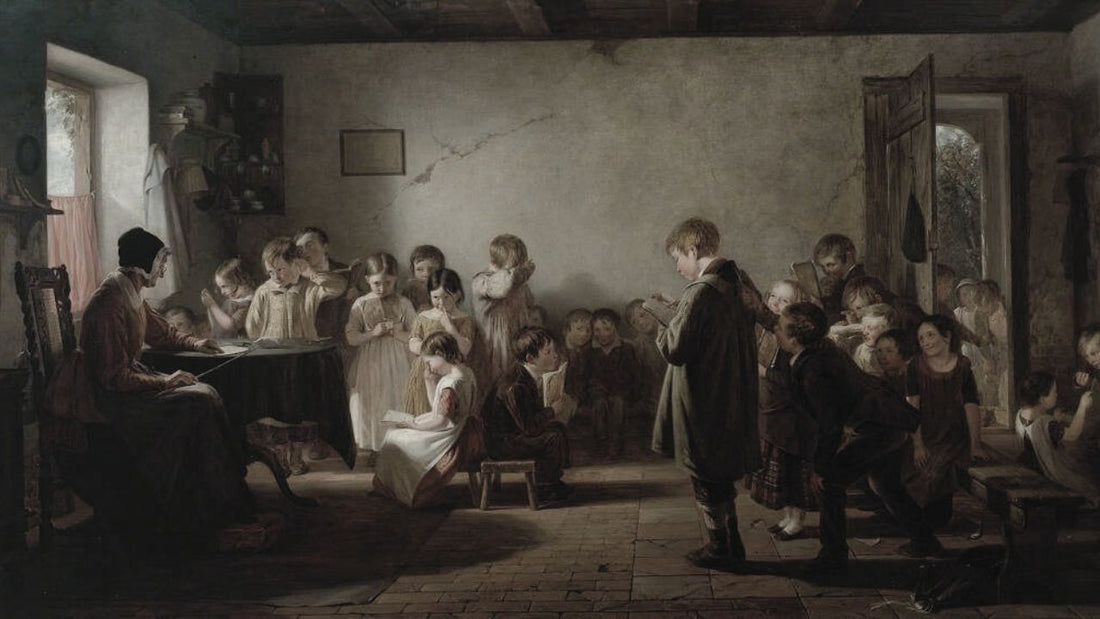
Stitched in Time: Marking Samplers and Women’s Education
What Were Marking Samplers?
A marking sampler was typically a square of linen or cotton stitched with the alphabet, numbers, and sometimes simple motifs or verses. The original purpose was practical: to teach girls how to “mark” household linens with initials for identification. But over time, this exercise grew into a central component of girls’ education.
Samplers helped teach literacy, numeracy, and sewing skills simultaneously. The alphabet was usually stitched in upper and lowercase, sometimes multiple times in different styles, alongside numbers and simple designs. The discipline required for this work was seen as a moral training ground, instilling patience, neatness, and obedience.

(E.L French Sampler, not charted yet)
Finishing Schools and the 'Accomplishments'
For middle- and upper-class girls, education was shaped by the goal of preparing them for marriage and genteel life. Finishing schools or private academies offered instruction in what were called the 'accomplishments'—music, drawing, French, etiquette, and embroidery.
Embroidery was not just a decorative pastime; it was a mark of a well-raised young woman. Samplers were often framed and displayed in homes as proof of a daughter’s refinement and moral upbringing. Religious verses or aphorisms stitched into samplers reinforced the values of piety, modesty, and industriousness.

Where Girls Learned to Stitch: Famous Finishing Schools and Female Academies
While many girls learned needlework at home or in local schools, some attended prestigious finishing schools and academies where embroidery—especially sampler-making—was an integral part of their education. These institutions not only taught sewing but also reinforced the social and moral ideals of the time.
Britain:
• Miss Linwood’s School, Leicester: Run by Mary Linwood, a renowned needlework artist in the late 18th and early 19th centuries.
• Ladies’ Seminaries in Bath: Home to several exclusive girls' schools where embroidery was a key part of education.
• Queen’s College, Harley Street, London (est. 1848): Though academically focused, it reflects the transition from traditional finishing schools.
United States:
• Bethlehem Female Seminary, Pennsylvania (founded 1742): One of the first girls' institutions in colonial America.
• Litchfield Female Academy, Connecticut (founded 1792): Combined academic learning with moral and domestic instruction.
• Troy Female Seminary (later Emma Willard School), New York (founded 1821): A pioneering school in female education.

Samplers as Résumés for the Poor
In contrast, working-class girls and orphans learned embroidery as a means of survival. Charity schools and parish institutions taught girls to make samplers as part of vocational training. These samplers weren’t about beauty—they were evidence of employable skills.
For a poor girl seeking work as a maid, governess, or seamstress, a well-made sampler could be the key to employment. It demonstrated literacy, diligence, and manual skill. Employers looked at these embroidered cloths much as we might scan a CV today.

The Humble Beginnings: Dame Schools and Early Needlework Instruction
For many working-class and rural girls, formal education was either brief or entirely out of reach. Instead, their first—and often only—schooling came from dame schools: small, informal classrooms run by women in their own homes.
Often run by widows or older women known as "dames," these schools offered basic instruction in literacy, numeracy, and religious study to very young children. Girls, in particular, were often taught sewing and embroidery alongside their letters.
Needlework in dame schools was modest but purposeful. Young girls might practice:
- Threading needles and tying knots
- Making simple running or cross stitches
- Marking initials on scraps of fabric
- Repairing small items of clothing
In many cases, a girl’s first stitches were made under the watchful eye of a dame, using whatever cloth and thread were available. These early skills laid the groundwork for more advanced sampler work—if the girl continued her education in a charity school or entered service where such skills were expected.
Dame schools were widespread in Britain and colonial America from the 1600s through the mid-1800s, especially in working-class neighborhoods. Though their quality varied greatly, they played a crucial role in teaching the practical basics of life—particularly the gendered skills that would shape a girl's future.
For some, this early exposure to needlework was the only formal “education” they would receive before entering the workforce. For others, it marked the beginning of a life of domestic labor, stitched into linen and necessity.

(Image by Thomas George Webster, A Dame's School, in England)
How Needlework Skills Were Used in the Household
Once employed, girls used sampler-taught skills daily in households:
1. Marking linens and garments
2. Mending and alterations
3. Sewing household goods
4. Decorative embroidery
5. Teaching younger children or siblings
These essential tasks made them valuable employees and were part of the expected 'feminine' skill set.

(My Great-grandmother's and Grandmother's initials on towels)
Symbolism and Social Identity
Marking samplers had become increasingly common and functional. In the early to mid-19th century, they expanded into symbolic and decorative expressions of identity and morality. Samplers reflected the moral ideals of the time: obedience, industry, piety, modesty. A girl might be judged not only by the neatness of her stitches, but by the verses she chose to embroider. Phrases like “Idleness is the root of all evil” or “Virtue is the greatest beauty” were common.
As time went on, some samplers evolved into elaborate personal records. Girls added floral borders, biblical scenes, family trees, or even embroidered maps. These changes mirrored shifting values in education and the growing expectation that a girl's accomplishments should reflect both her skill and her character.
The Enduring Legacy
Many samplers survive today, preserved in museums or passed down through families. They remain a poignant reminder of the hidden labor of women and girls, and how education was once measured not in grades or degrees, but in the neatness of a cross-stitch and the moral clarity of a verse.... Measured not by grades, but by stitch and verse, their legacy continues to tell stories of resilience and creativity.
In every sampler, there’s a story—of a young girl, a societal expectation, and the silent power of learning stitched into cloth.

(Grace Leaman 1781 Sampler)
The image below is from a Russian school, it shows the different skill levels of the students. The ones in the front row are still learning, while the back row is working on elaborate embroideries.

(Image by Karl Karlovitz Bulla (Russian, 1854 - 1929)
Below is a "Hornbook"
Horn books, battledore books and crisscross books were all tablets designed primarily to teach the alphabet to children. Laid out as an abecedarium, the elementary method of teaching used from the 15th to the 18th century, consisting of a sheet of paper (or parchment) mounted on a thin wooden paddle, usually with a handle that was perforated so that the hornbook could be hung at the child’s girdle, or belt. The sheet usually had the alphabet, some pairs of letters, and a religious verse, often the Lord's Prayer. Because paper was so expensive, parents and teachers wanted to protect it. So they covered the paper with a very thin piece of cow's horn which was so thin, you could see right through it. Thus, the name, hornbook came to be used to describe this type of “book.”


9 comments
This article was very fascinating. I’ve been stitching since a small child. My question is…. I’ve noticed that many of the samplers with alphabets are missing letters. I am working on one now that was missing the T and U. I re-worked it. Was it common for girls to leave letters out? Very interesting. (I think a story about the process on how they got those horns so thin would also be interesting.) Thanks again.
Gayla :)
What a wonderful summary-I learned some new things this morning! Had not seen this info on the hornbook before-so interesting! Thank you!
Hello. Your blogs are so interesting. I find the glimpse into the past fascinating. I’ve seen present day hornbooks that stitchers are using and always wondered how it got the name and its purpose. To think the horn someone could get a piece of horn so thin it was translucent. Amazing. I look forward to more blogs and the history of stitching. Regards, Elaine
Thanks for sharing the story of early samplers. It is very interesting. Thanks!
A wonderful summary. Thank you for writing this.